Motivational Theory: Critiquing McGregor's Theory X and Theory Y
VerifiedAdded on 2019/10/18
|6
|1532
|121
Essay
AI Summary
This essay critically analyzes Douglas McGregor's Theory X and Theory Y of motivational theory. The assignment explores the core tenets of each theory, contrasting the assumptions managers make about employees and their work ethic. Theory X posits that employees are inherently unmotivated and require close supervision, while Theory Y suggests employees are self-motivated and seek responsibility. The essay presents the author's disagreement with the theories, arguing they oversimplify employee attributes and may hinder effective employment practices. The author critiques the theories' reliance on assumptions and their potential obsolescence in today's diverse and technologically advanced workplaces. The essay also highlights the limitations of McGregor's research methodology, emphasizing that the theories were based on perceptions rather than empirical data. The author concludes that while the theories might be applicable to some organizations, they are not widely relevant for advanced organizations. The essay uses supporting references to strengthen its arguments.
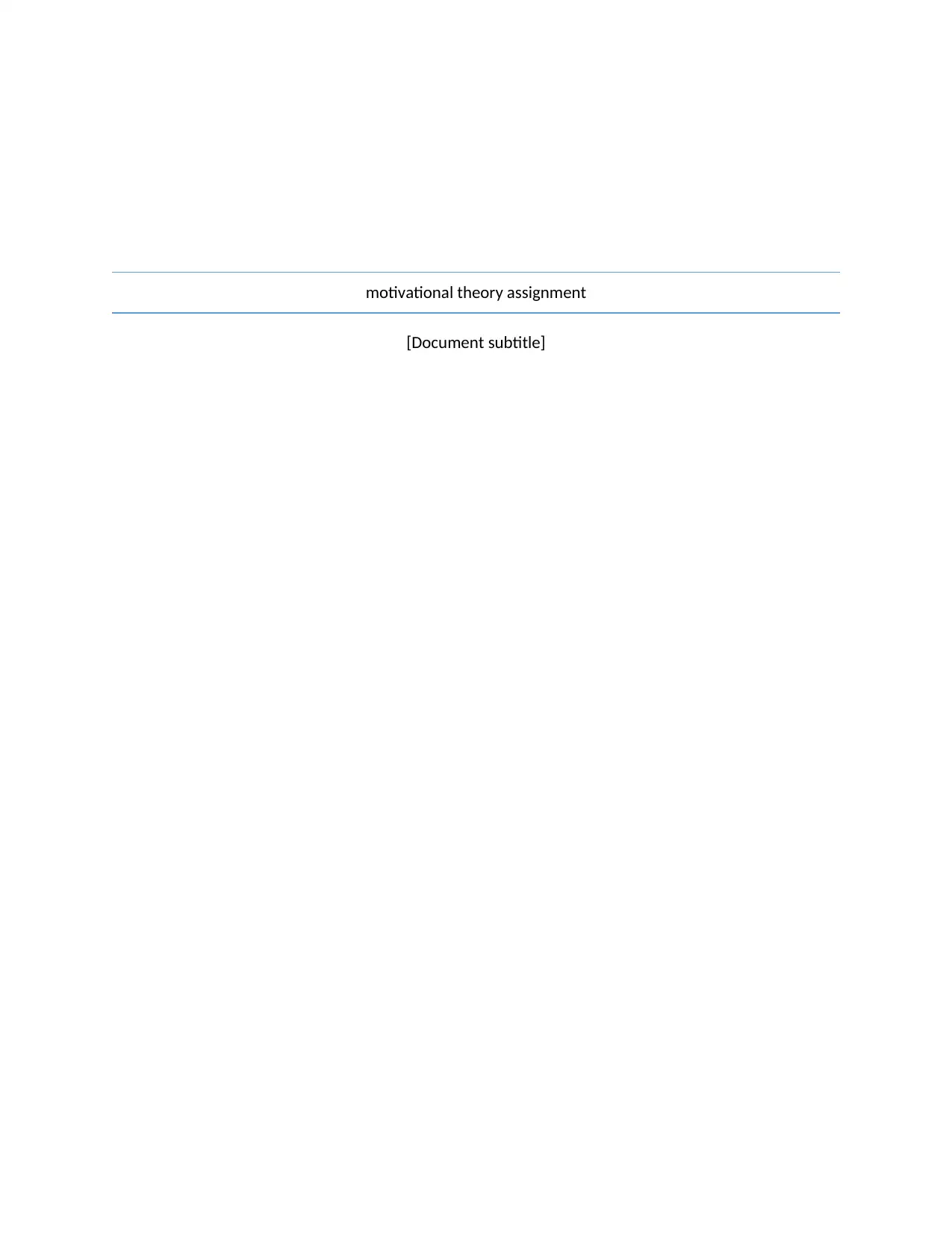
motivational theory assignment
[Document subtitle]
[Document subtitle]
Paraphrase This Document
Need a fresh take? Get an instant paraphrase of this document with our AI Paraphraser
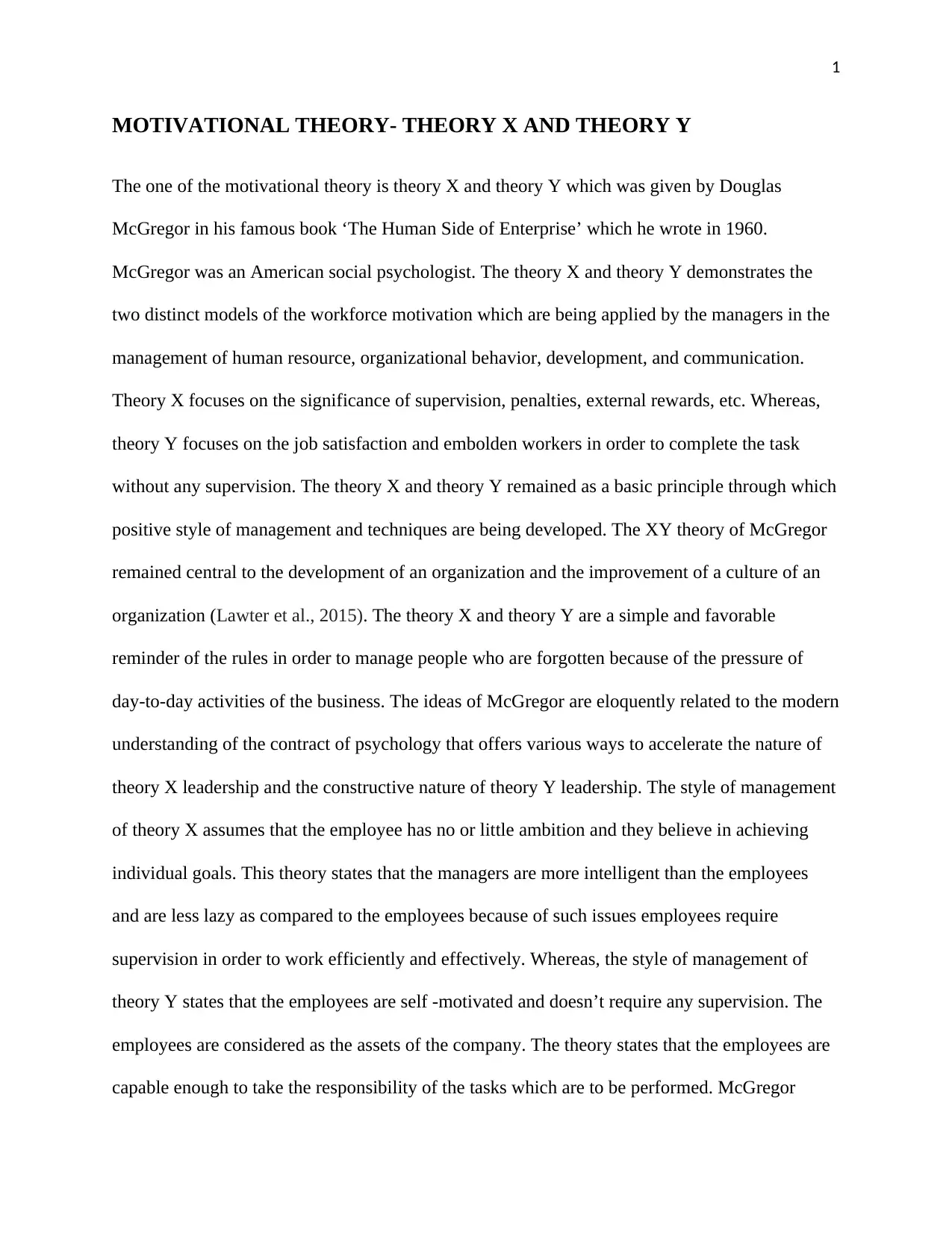
1
MOTIVATIONAL THEORY- THEORY X AND THEORY Y
The one of the motivational theory is theory X and theory Y which was given by Douglas
McGregor in his famous book ‘The Human Side of Enterprise’ which he wrote in 1960.
McGregor was an American social psychologist. The theory X and theory Y demonstrates the
two distinct models of the workforce motivation which are being applied by the managers in the
management of human resource, organizational behavior, development, and communication.
Theory X focuses on the significance of supervision, penalties, external rewards, etc. Whereas,
theory Y focuses on the job satisfaction and embolden workers in order to complete the task
without any supervision. The theory X and theory Y remained as a basic principle through which
positive style of management and techniques are being developed. The XY theory of McGregor
remained central to the development of an organization and the improvement of a culture of an
organization (Lawter et al., 2015). The theory X and theory Y are a simple and favorable
reminder of the rules in order to manage people who are forgotten because of the pressure of
day-to-day activities of the business. The ideas of McGregor are eloquently related to the modern
understanding of the contract of psychology that offers various ways to accelerate the nature of
theory X leadership and the constructive nature of theory Y leadership. The style of management
of theory X assumes that the employee has no or little ambition and they believe in achieving
individual goals. This theory states that the managers are more intelligent than the employees
and are less lazy as compared to the employees because of such issues employees require
supervision in order to work efficiently and effectively. Whereas, the style of management of
theory Y states that the employees are self -motivated and doesn’t require any supervision. The
employees are considered as the assets of the company. The theory states that the employees are
capable enough to take the responsibility of the tasks which are to be performed. McGregor
MOTIVATIONAL THEORY- THEORY X AND THEORY Y
The one of the motivational theory is theory X and theory Y which was given by Douglas
McGregor in his famous book ‘The Human Side of Enterprise’ which he wrote in 1960.
McGregor was an American social psychologist. The theory X and theory Y demonstrates the
two distinct models of the workforce motivation which are being applied by the managers in the
management of human resource, organizational behavior, development, and communication.
Theory X focuses on the significance of supervision, penalties, external rewards, etc. Whereas,
theory Y focuses on the job satisfaction and embolden workers in order to complete the task
without any supervision. The theory X and theory Y remained as a basic principle through which
positive style of management and techniques are being developed. The XY theory of McGregor
remained central to the development of an organization and the improvement of a culture of an
organization (Lawter et al., 2015). The theory X and theory Y are a simple and favorable
reminder of the rules in order to manage people who are forgotten because of the pressure of
day-to-day activities of the business. The ideas of McGregor are eloquently related to the modern
understanding of the contract of psychology that offers various ways to accelerate the nature of
theory X leadership and the constructive nature of theory Y leadership. The style of management
of theory X assumes that the employee has no or little ambition and they believe in achieving
individual goals. This theory states that the managers are more intelligent than the employees
and are less lazy as compared to the employees because of such issues employees require
supervision in order to work efficiently and effectively. Whereas, the style of management of
theory Y states that the employees are self -motivated and doesn’t require any supervision. The
employees are considered as the assets of the company. The theory states that the employees are
capable enough to take the responsibility of the tasks which are to be performed. McGregor
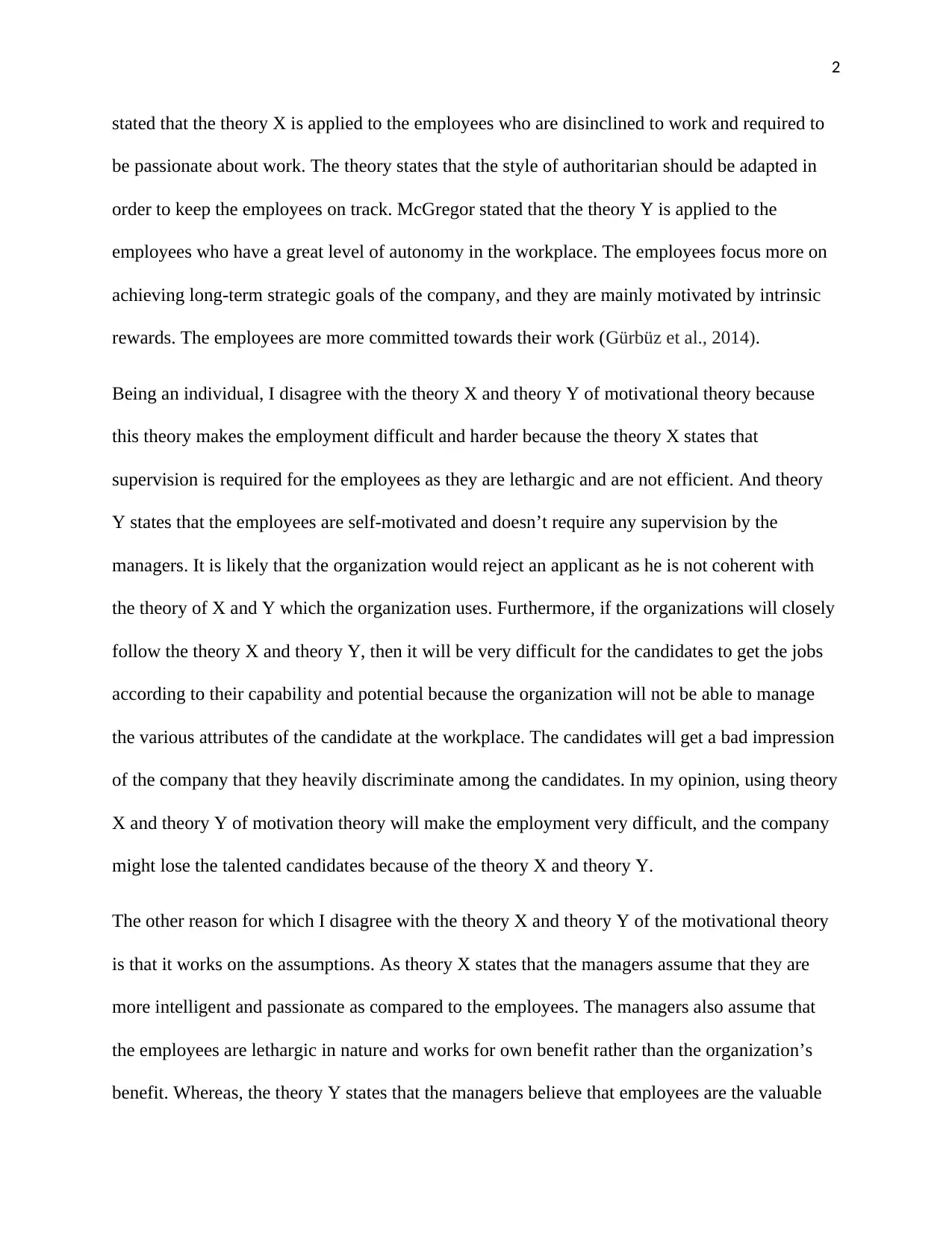
2
stated that the theory X is applied to the employees who are disinclined to work and required to
be passionate about work. The theory states that the style of authoritarian should be adapted in
order to keep the employees on track. McGregor stated that the theory Y is applied to the
employees who have a great level of autonomy in the workplace. The employees focus more on
achieving long-term strategic goals of the company, and they are mainly motivated by intrinsic
rewards. The employees are more committed towards their work (Gürbüz et al., 2014).
Being an individual, I disagree with the theory X and theory Y of motivational theory because
this theory makes the employment difficult and harder because the theory X states that
supervision is required for the employees as they are lethargic and are not efficient. And theory
Y states that the employees are self-motivated and doesn’t require any supervision by the
managers. It is likely that the organization would reject an applicant as he is not coherent with
the theory of X and Y which the organization uses. Furthermore, if the organizations will closely
follow the theory X and theory Y, then it will be very difficult for the candidates to get the jobs
according to their capability and potential because the organization will not be able to manage
the various attributes of the candidate at the workplace. The candidates will get a bad impression
of the company that they heavily discriminate among the candidates. In my opinion, using theory
X and theory Y of motivation theory will make the employment very difficult, and the company
might lose the talented candidates because of the theory X and theory Y.
The other reason for which I disagree with the theory X and theory Y of the motivational theory
is that it works on the assumptions. As theory X states that the managers assume that they are
more intelligent and passionate as compared to the employees. The managers also assume that
the employees are lethargic in nature and works for own benefit rather than the organization’s
benefit. Whereas, the theory Y states that the managers believe that employees are the valuable
stated that the theory X is applied to the employees who are disinclined to work and required to
be passionate about work. The theory states that the style of authoritarian should be adapted in
order to keep the employees on track. McGregor stated that the theory Y is applied to the
employees who have a great level of autonomy in the workplace. The employees focus more on
achieving long-term strategic goals of the company, and they are mainly motivated by intrinsic
rewards. The employees are more committed towards their work (Gürbüz et al., 2014).
Being an individual, I disagree with the theory X and theory Y of motivational theory because
this theory makes the employment difficult and harder because the theory X states that
supervision is required for the employees as they are lethargic and are not efficient. And theory
Y states that the employees are self-motivated and doesn’t require any supervision by the
managers. It is likely that the organization would reject an applicant as he is not coherent with
the theory of X and Y which the organization uses. Furthermore, if the organizations will closely
follow the theory X and theory Y, then it will be very difficult for the candidates to get the jobs
according to their capability and potential because the organization will not be able to manage
the various attributes of the candidate at the workplace. The candidates will get a bad impression
of the company that they heavily discriminate among the candidates. In my opinion, using theory
X and theory Y of motivation theory will make the employment very difficult, and the company
might lose the talented candidates because of the theory X and theory Y.
The other reason for which I disagree with the theory X and theory Y of the motivational theory
is that it works on the assumptions. As theory X states that the managers assume that they are
more intelligent and passionate as compared to the employees. The managers also assume that
the employees are lethargic in nature and works for own benefit rather than the organization’s
benefit. Whereas, the theory Y states that the managers believe that employees are the valuable
⊘ This is a preview!⊘
Do you want full access?
Subscribe today to unlock all pages.

Trusted by 1+ million students worldwide
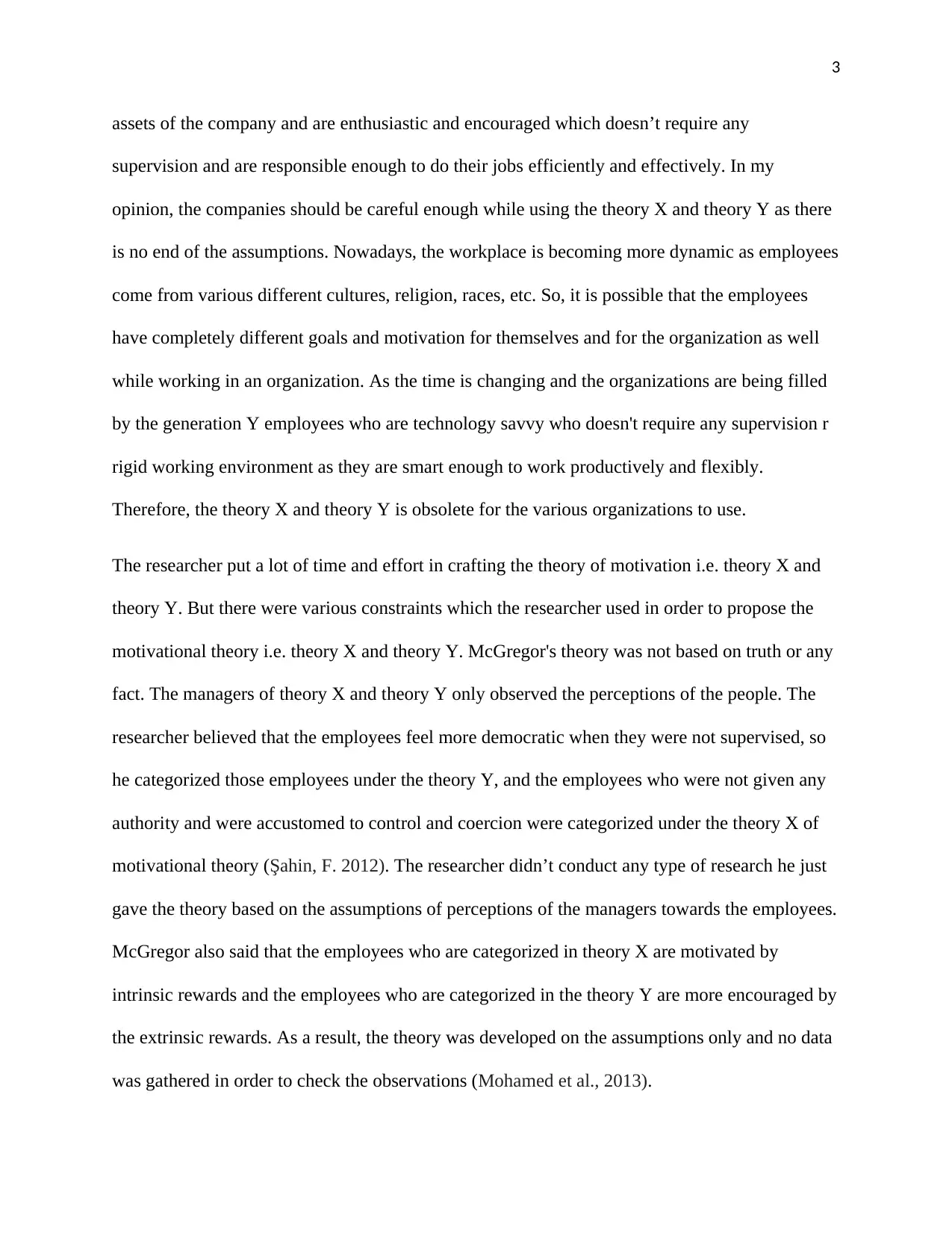
3
assets of the company and are enthusiastic and encouraged which doesn’t require any
supervision and are responsible enough to do their jobs efficiently and effectively. In my
opinion, the companies should be careful enough while using the theory X and theory Y as there
is no end of the assumptions. Nowadays, the workplace is becoming more dynamic as employees
come from various different cultures, religion, races, etc. So, it is possible that the employees
have completely different goals and motivation for themselves and for the organization as well
while working in an organization. As the time is changing and the organizations are being filled
by the generation Y employees who are technology savvy who doesn't require any supervision r
rigid working environment as they are smart enough to work productively and flexibly.
Therefore, the theory X and theory Y is obsolete for the various organizations to use.
The researcher put a lot of time and effort in crafting the theory of motivation i.e. theory X and
theory Y. But there were various constraints which the researcher used in order to propose the
motivational theory i.e. theory X and theory Y. McGregor's theory was not based on truth or any
fact. The managers of theory X and theory Y only observed the perceptions of the people. The
researcher believed that the employees feel more democratic when they were not supervised, so
he categorized those employees under the theory Y, and the employees who were not given any
authority and were accustomed to control and coercion were categorized under the theory X of
motivational theory (Şahin, F. 2012). The researcher didn’t conduct any type of research he just
gave the theory based on the assumptions of perceptions of the managers towards the employees.
McGregor also said that the employees who are categorized in theory X are motivated by
intrinsic rewards and the employees who are categorized in the theory Y are more encouraged by
the extrinsic rewards. As a result, the theory was developed on the assumptions only and no data
was gathered in order to check the observations (Mohamed et al., 2013).
assets of the company and are enthusiastic and encouraged which doesn’t require any
supervision and are responsible enough to do their jobs efficiently and effectively. In my
opinion, the companies should be careful enough while using the theory X and theory Y as there
is no end of the assumptions. Nowadays, the workplace is becoming more dynamic as employees
come from various different cultures, religion, races, etc. So, it is possible that the employees
have completely different goals and motivation for themselves and for the organization as well
while working in an organization. As the time is changing and the organizations are being filled
by the generation Y employees who are technology savvy who doesn't require any supervision r
rigid working environment as they are smart enough to work productively and flexibly.
Therefore, the theory X and theory Y is obsolete for the various organizations to use.
The researcher put a lot of time and effort in crafting the theory of motivation i.e. theory X and
theory Y. But there were various constraints which the researcher used in order to propose the
motivational theory i.e. theory X and theory Y. McGregor's theory was not based on truth or any
fact. The managers of theory X and theory Y only observed the perceptions of the people. The
researcher believed that the employees feel more democratic when they were not supervised, so
he categorized those employees under the theory Y, and the employees who were not given any
authority and were accustomed to control and coercion were categorized under the theory X of
motivational theory (Şahin, F. 2012). The researcher didn’t conduct any type of research he just
gave the theory based on the assumptions of perceptions of the managers towards the employees.
McGregor also said that the employees who are categorized in theory X are motivated by
intrinsic rewards and the employees who are categorized in the theory Y are more encouraged by
the extrinsic rewards. As a result, the theory was developed on the assumptions only and no data
was gathered in order to check the observations (Mohamed et al., 2013).
Paraphrase This Document
Need a fresh take? Get an instant paraphrase of this document with our AI Paraphraser
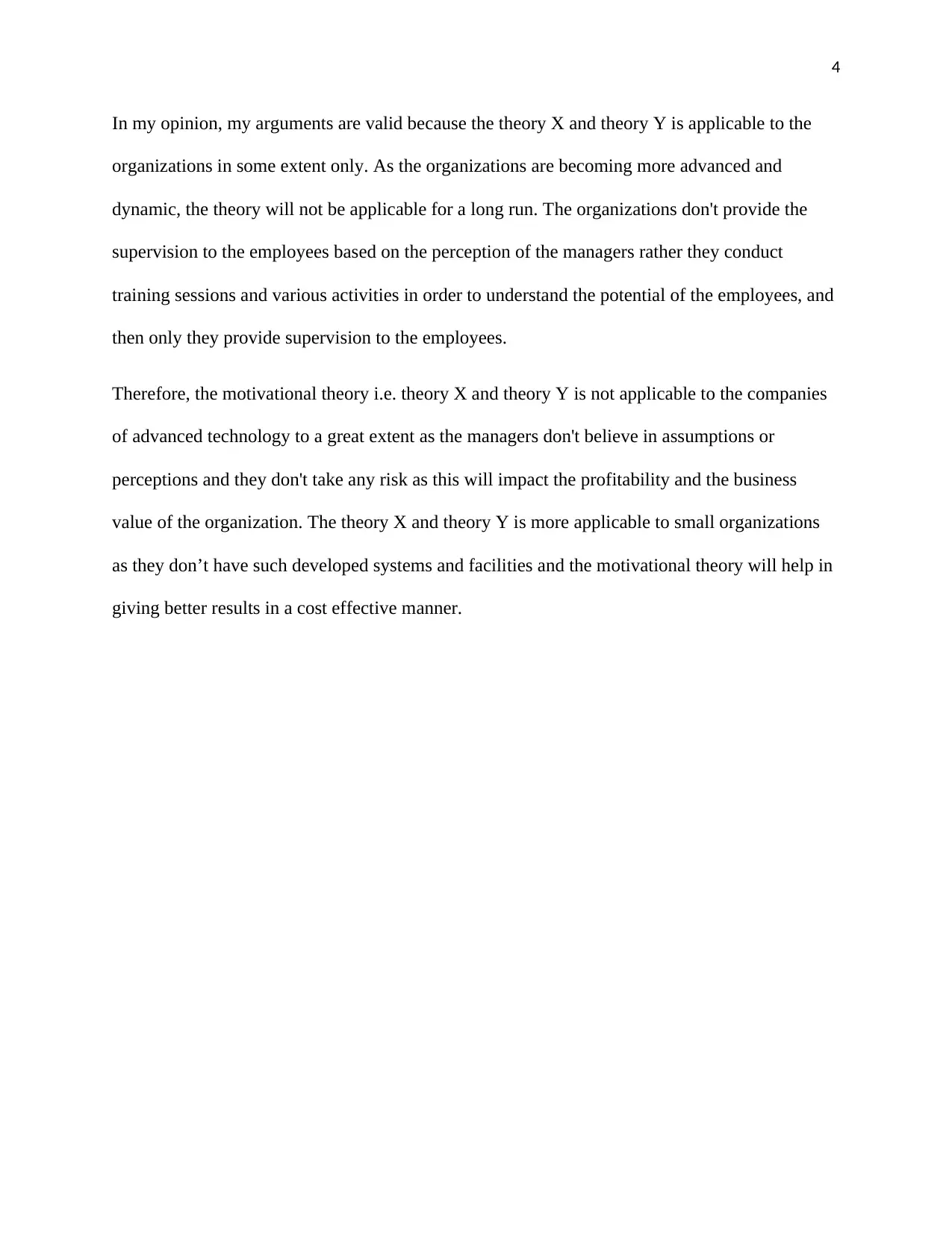
4
In my opinion, my arguments are valid because the theory X and theory Y is applicable to the
organizations in some extent only. As the organizations are becoming more advanced and
dynamic, the theory will not be applicable for a long run. The organizations don't provide the
supervision to the employees based on the perception of the managers rather they conduct
training sessions and various activities in order to understand the potential of the employees, and
then only they provide supervision to the employees.
Therefore, the motivational theory i.e. theory X and theory Y is not applicable to the companies
of advanced technology to a great extent as the managers don't believe in assumptions or
perceptions and they don't take any risk as this will impact the profitability and the business
value of the organization. The theory X and theory Y is more applicable to small organizations
as they don’t have such developed systems and facilities and the motivational theory will help in
giving better results in a cost effective manner.
In my opinion, my arguments are valid because the theory X and theory Y is applicable to the
organizations in some extent only. As the organizations are becoming more advanced and
dynamic, the theory will not be applicable for a long run. The organizations don't provide the
supervision to the employees based on the perception of the managers rather they conduct
training sessions and various activities in order to understand the potential of the employees, and
then only they provide supervision to the employees.
Therefore, the motivational theory i.e. theory X and theory Y is not applicable to the companies
of advanced technology to a great extent as the managers don't believe in assumptions or
perceptions and they don't take any risk as this will impact the profitability and the business
value of the organization. The theory X and theory Y is more applicable to small organizations
as they don’t have such developed systems and facilities and the motivational theory will help in
giving better results in a cost effective manner.
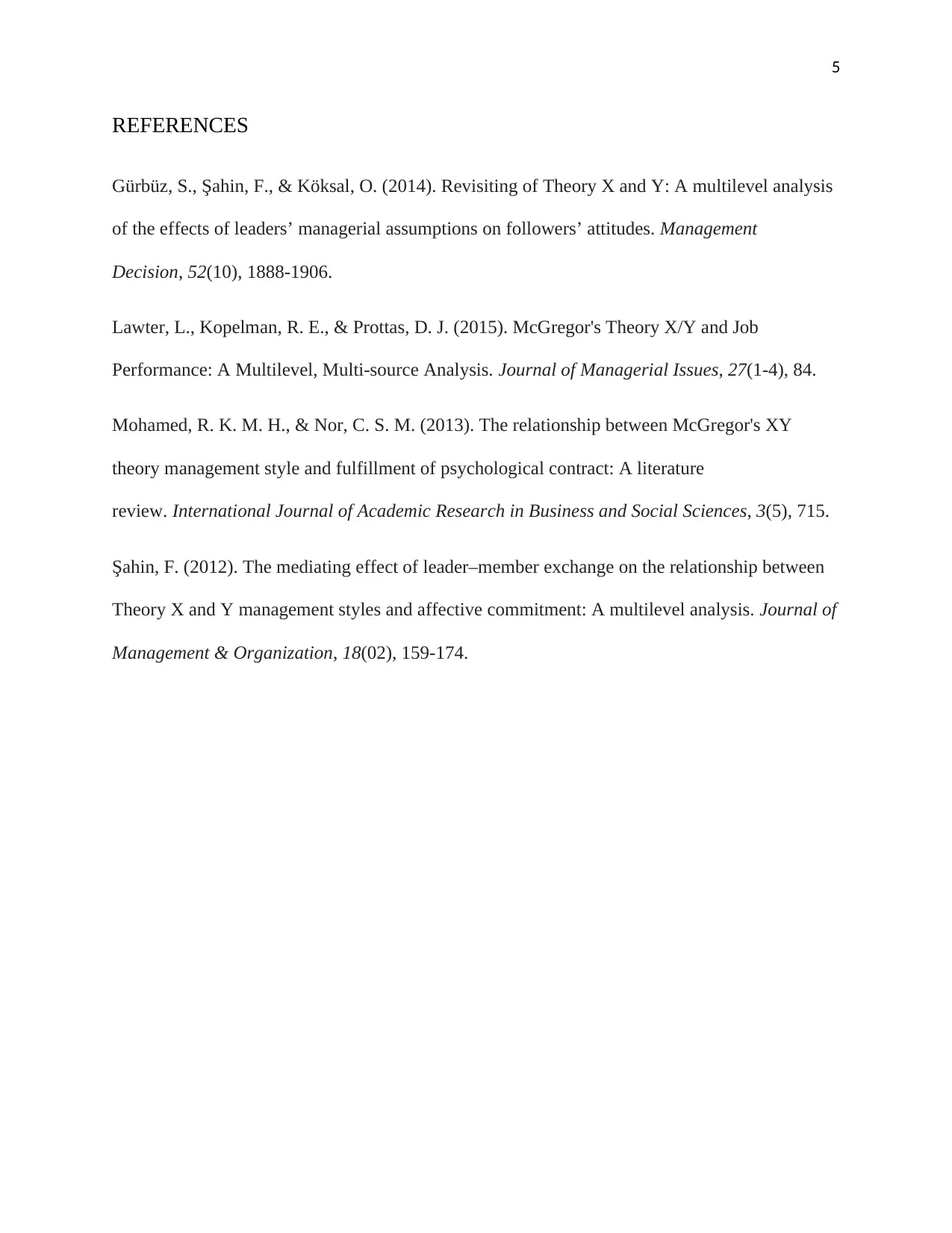
5
REFERENCES
Gürbüz, S., Şahin, F., & Köksal, O. (2014). Revisiting of Theory X and Y: A multilevel analysis
of the effects of leaders’ managerial assumptions on followers’ attitudes. Management
Decision, 52(10), 1888-1906.
Lawter, L., Kopelman, R. E., & Prottas, D. J. (2015). McGregor's Theory X/Y and Job
Performance: A Multilevel, Multi-source Analysis. Journal of Managerial Issues, 27(1-4), 84.
Mohamed, R. K. M. H., & Nor, C. S. M. (2013). The relationship between McGregor's XY
theory management style and fulfillment of psychological contract: A literature
review. International Journal of Academic Research in Business and Social Sciences, 3(5), 715.
Şahin, F. (2012). The mediating effect of leader–member exchange on the relationship between
Theory X and Y management styles and affective commitment: A multilevel analysis. Journal of
Management & Organization, 18(02), 159-174.
REFERENCES
Gürbüz, S., Şahin, F., & Köksal, O. (2014). Revisiting of Theory X and Y: A multilevel analysis
of the effects of leaders’ managerial assumptions on followers’ attitudes. Management
Decision, 52(10), 1888-1906.
Lawter, L., Kopelman, R. E., & Prottas, D. J. (2015). McGregor's Theory X/Y and Job
Performance: A Multilevel, Multi-source Analysis. Journal of Managerial Issues, 27(1-4), 84.
Mohamed, R. K. M. H., & Nor, C. S. M. (2013). The relationship between McGregor's XY
theory management style and fulfillment of psychological contract: A literature
review. International Journal of Academic Research in Business and Social Sciences, 3(5), 715.
Şahin, F. (2012). The mediating effect of leader–member exchange on the relationship between
Theory X and Y management styles and affective commitment: A multilevel analysis. Journal of
Management & Organization, 18(02), 159-174.
⊘ This is a preview!⊘
Do you want full access?
Subscribe today to unlock all pages.

Trusted by 1+ million students worldwide
1 out of 6
Related Documents
Your All-in-One AI-Powered Toolkit for Academic Success.
+13062052269
info@desklib.com
Available 24*7 on WhatsApp / Email
![[object Object]](/_next/static/media/star-bottom.7253800d.svg)
Unlock your academic potential
Copyright © 2020–2026 A2Z Services. All Rights Reserved. Developed and managed by ZUCOL.





